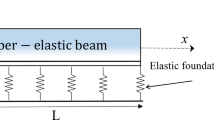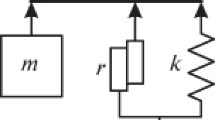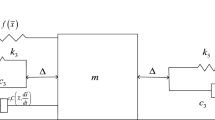Abstract
The issue of vibration damping occurs in many mechanical problems in the operation of various devices, in the automotive industry engineering, aerospace. In the case where damping by selection of the masses and dimensions is not possible due to various reasons or for other reasons it was abandoned, vibration dampers are used. Minimization of adverse impact of dynamic interaction effects is an important research and technical problem. Passive energy absorbers used today (complex of bumpers, passenger lifts buffers typically allows to the safe dissipation of energy within a certain range of loads. In the case of high-impact loading variability is desirable to use an adaptive energy absorption system capable of rapid change their dynamic characteristics. The main issue in the analysis of interactions impact of dynamic loads on objects is dispersion (dissipation) of kinetic energy during impact. In paper a description of model of internal damping was proposed with the proof the influence of component part of polynomial. For example elastomer material EPUNIT will be used to present prepare the buildings of model hyperdeform material. Was present conclusion of analyses systems hyperdeform composite materials.
Similar content being viewed by others
Avoid common mistakes on your manuscript.
1 Introduction
The issue of vibration damping occurs in many mechanical problems in the operation of various devices in the automotive industry engineering, aerospace. In the case where damping by selection of the masses and dimensions is not possible due to various reasons or for other reasons it was abandoned, vibration dampers are used [1].
Minimization of adverse impact of dynamic interaction effects is an important research and technical problem. Passive energy absorbers used today (complex of bumpers, passenger lifts buffers typically allows to the safe dissipation of energy within a certain range of loads [2, 3]. In the case of high-impact loading variability is desirable to use an adaptive energy absorption system capable of rapid change their dynamic characteristics [4]. The main issue in the analysis of interactions impact of dynamic loads on objects is dispersion (dissipation) of kinetic energy during impact [5].
The energy dissipation is the irreversible process of transforming structured forms macroscopic movement of energy distributed randomly in a number of degrees of freedom, usually in the thermal energy of the movement of microparticles (increasing the relative amount of thermal energy of the system and increases its entropy) [6]. Dissipative processes occur in systems in which the interaction between mating components, or within the structure of the material occur as a result of friction, viscous characteristics of the material, among others. following: changes in process temperature, deformation speed.
2 The model of internal damping in hyperdeforms materials
The features of elastomers materials were wildly examined in the activities [7–10], in this among other things segment polyurethane EPUNIT. These are a modern constructional material with a high useful features. There are wildly used in industry because of their wear resistant, especially for those parts using in conditions of mineral processing.
An interest in this materials is a result of capability of creating both chemical and physical structures. Using substrates of different chemical structure or variable molar ratio of the same substrates gives various polymers with different features (chemical and material structure) that can be used for specific purpose [11]. Experimental investigations of EPUNIT material were conducted in connection with their possible use in motor vehicle and aircraft industry.
The physics–chemical and strength features of segment polyurethane (calculate according with [10]) put in Table 1.
A polynomial model reduced of the sixth order was used for describing the elastic features. In the model of polynomial was used invariant form function of energy of figural deformation \(W\) written by the Eq. (1):
where \(W\) is figural deformation energy, \({\overline{I_1}}\) is first invariant strain tensor Cauchy’s–Green’s, \({\overline{I_2}}\) is second invariant strain tensor Cuachy’s–Green’s, \(\hbox {C}_\mathrm{i}\) is material constants, \(\hbox {C}_{00} =0\) is material constant, \(\upmu _{0}\) is the initial transverse modulus of elasticity initial ratio, in which a first element of this formula describing a figural deformation—first invariant of deviator part of deformation is (2):
Second module of dependence (3) it describes the volumetric deformations—third invariant of state of deformation (being with measure of change of volume) the figure has:
Dissipation function define as (4):
Was accepted main direction and introduced in figure with strength of suppression (5) to characterize vibration about one degree discretion (5):
where \({\dot{\uplambda }}_{\mathrm{i}}^{\mathrm{i}}\) is the speed of deformation, \(c_{i}\) is the dumping coefficients.
The viscosity properties—the damping level dependent of many parameters: the composition of, structure, of building and composition segments, additions modificatory, the technology of production. The quantitative estimate could be execute only by use the results of experimental investigations. Arrangement was has given an examination described with Eq. (6):
where m is mass of element, \(k\) is elastic modulus.
A coefficients \(\hbox {k}_{\mathrm{i}}\) was accepted with results of investigations [10, 11]. The different possibilities of selection damping coefficients \(\hbox {c}_{\mathrm{i}}\) were considered. According with theory of hyperdeform materials the largest \(n\) value was accepted n = 6. The results of executed tests and numerical calculation proved that the only odd components of explication had meaning the calculations one—accepted so the reduction, the components about numbers in modules of equation took into account i = 1, 3, 5. It the hysteresis loops in aim of comparison were executed: experimentally and used numerical calculation, by loading and unloading with slowly growing strength and dynamic in arrangement serf harmonic load. It was any tests variants considered: the samples materials differing with arrangement: the proportion of soft and straight piece, with regard on propriety of material—in different temperatures.
3 Internal damping in polymers elastomers materials
The simulations were executed the free numeric oscillation. Non-linear oscillation the occurrence in results was observed. Results are convergent with theoretical base with this field [1, 12, 13].
It the comparison of course of oscillation On Fig. 1 was introduced course of oscillation from linear damping and non-linear damping (on Fig. 2). We can see clear influence of non-linear on result of answer of arrangement.
It resonance curves on Fig. 3 were introduced was: (1) without damping, (2) with insignificant level suppression—was accepted \(c_{i}= 0.002\). Visible it is that the typical sights of non-linear damping in system from hyperdeforms composite unit step out: the offset of resonance frequency in side of higher frequencies and the sudden reduction of amplitude after passage of resonance.
4 Evaluation of energy dissipation in systems with hyperdeformable polymres
The analysis with assumption of real hyperdeformable material properties into the equation requires differentiating feature for loading and unloading phases [14]. For analysis the equation system describing the vibrating elastic element made of an incompressible elastomer—according to the Eq. (7):
It was also assumed that there is a viscous damping. Vibrations are described by the Eq. (8)
where b is damping factor.
Taken into account the extortion of the coverage elastomer systems work in the area of compressive loads (9):
where \(\omega \) is frequency of the exciting force, \(F(t)\) is time variable forcing function.
Cellasto closed cell elastomer was taken to considerations. Material properties are defined using the results of experimental studies [14].
It was a clear effect of non-linearity, which is characterized in that the amplitude does not reach the infinitely large value for the finite frequency [1]. With an increase in the amplitude of the resonance zone moves in the direction of higher frequency. Figure 4 contains a non-linear dependence between the frequency of vibration amplitude of the curve in the form of skeletal structure obtained for the polyurethane foam Cellasto 550.
The effects of nonlinear damping pointing to the need for an individual description of the different stages, namely: loading and unloading. For this purpose, Eq. (7) was modified by introducing a record defining the various attenuation values for the individual phases of the element, in the form of (10):
where \(J=\left\{ {\begin{array}{l} 1\dot{x}>0 \\ 0\dot{x}\le 0\\ \end{array}} \right\} \) -ones zero function described with dependence, \(\hbox {c}_{1}, \hbox {c}_{2}\) -damping coefficients, where \(\hbox {c}_{1}<<\hbox {c}_{2}\).
Compared the responses obtained by numerical simulations for the elastomeric component. Results were obtained considering the description for the suppression of homogeneous deformation and is defined as an unbalanced individual for the individual stages ie. loading and unloading. It was found that The latter approach offers allows for to obtain closer to a real solution, comparable with experimental results.
5 Conclusions
In study was introduced the method of identification of propriety of viscoelastic hyperdeform materials. Affirm, that to description of materials about small compressibility (practically incompressible) are better the multinomial model. To model in case of large compressibility larger exactitude guarantee the Ogden model (different lines).
Experimental tests permitted on ascertainment that stresses with growth of content, was also observed increase in value Young module, durability on bumping and tearing apart, plastic deformation, hardness, and waste abrasive thickness grows larger also, to break decrescent deformation and buffering.
It has been shown that the behavior of the system constructed on the basis of a polymeric component, in particular a hyper deformable material eg. polyurethane elastomer, to a large extent depend on the temperature of the system, as well as the deformation speed.
The description of behaviour the arrangement from hyperdeform composite element should to take into account requires differentiating feature for loading and unloading phases.
References
Osiński Z (1998) Damping of vibration. A. A. Balkema, Rottherdam
Wielgos P (2010) Reviev of effectiveness of working multiple tune of mass dampers in building constructions. Doctoral Thesis. Lublin University of Technology, Lublin
Pawlowski PK (2011) Systems of adaptive absorption of percussive load. Doctoral Thesis. Polish Academy of Sciences, Warsaw
Amborski J, Osiński J (2005) The conception of elastomer dumper to use in the air–chassis, IX The scientificaly-technically conference, FEM programs in computer aid of analysis, the projection and production, Giżycko 2005, pp 469–480
Porębska R, Mazurkiewicz S (2009) Dissipated energy in polymetric composites Energia dyssypacji w kompozytach polimerowych, Technical, Transactions, z.3, s.245–248, 1-M/2009
Cach R (2001) Phisicist encyclopaedicdictionary. Wydawnictwo Europa, Wroclaw
Osiński J, Żach P (2008) Physics and chemically profiles of hyperdeforms materials. Dwumiesięcznik Techniczno-Informacyjny Tworzywa Sztuczne i Chemia 5(42):52–57
Żach P (2006) Poriform plastics tests used in production of car armchairs. Dwumiesięcznik Techniczno-Informacyjny Tworzywa Sztuczne i Chemia 5(30):12–19
Żach P (2006) Polymer poriform structure. Dwumiesięcznik Techniczno-Informacyjny Tworzywa Sztuczne i Chemia 2(27):11–16
Boczkowska A, Babski K, Osiński J, Żach P (2008) Identification of viscoelastic properties of hyperelastic materials. Polymers
Boczkowska A (2000) A constructional polymers from crystalline eterouretanodiizocyjanowych substrata’s. Doctoral Thesis. Warsaw University of Technology, Warsaw
Amborski J (2005) The vibration damper modelling from elastomers material with FEM. Doctoral Thesis. Warsaw University of Technology, Warsaw
De Silva, Clarence W (2000) Vibration. CRC Press, Boca Raton
Żach P (2013) Structural identification of the spring and damping quality for hyperdeform materials. ITER Warsaw
Jungowski A (2007) The experimental tests of hyperelastics materials in room temperature. The Master’s Thesis. Warsaw University of Technology, Warsaw
Author information
Authors and Affiliations
Corresponding author
Rights and permissions
Open Access This article is distributed under the terms of the Creative Commons Attribution License which permits any use, distribution, and reproduction in any medium, provided the original author(s) and the source are credited.
About this article
Cite this article
Żach, P. Description of phenomena vibration in hyperdeform polymers materials. Int. J. Dynam. Control 3, 36–40 (2015). https://doi.org/10.1007/s40435-014-0069-6
Received:
Revised:
Accepted:
Published:
Issue Date:
DOI: https://doi.org/10.1007/s40435-014-0069-6








